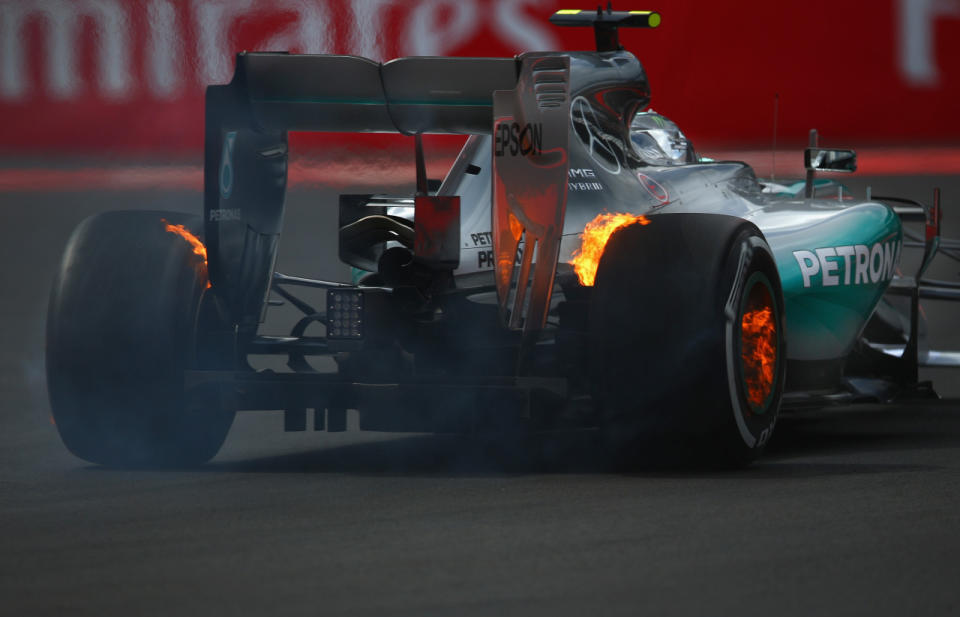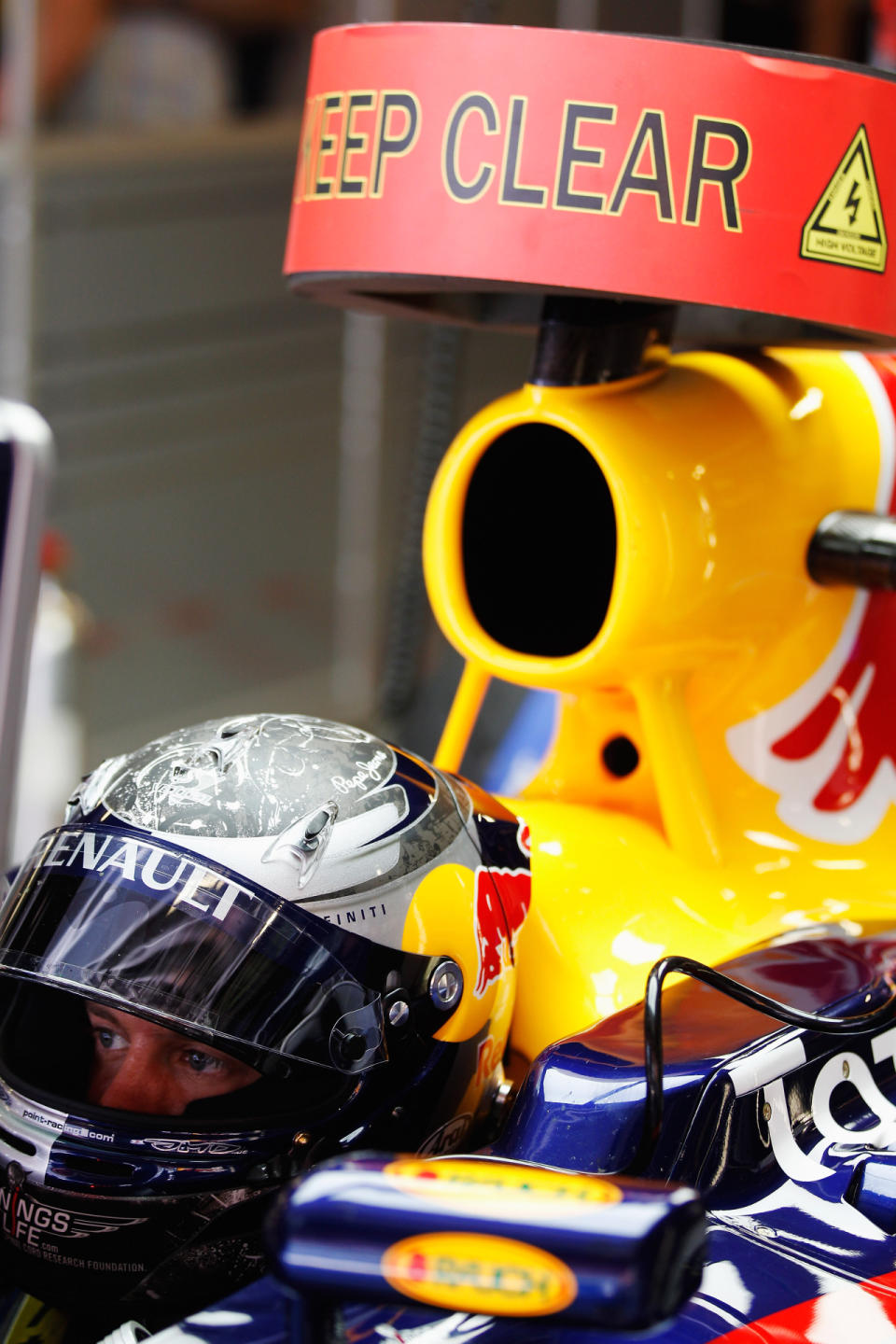The amazing transformation of F1 brakes

The brakes on a modern F1 car have fearsome stopping abilities, helping drivers decelerate smoothly at up to 5g, lap after lap.
In contrast, even the best road cars can manage only 1-1.5g.
Now, this isn’t all down to brakes alone – downforce, size and stickiness of tyres and weight of car all have a huge bearing on braking ability but it’s the braking system that lets a driver control deceleration reliably and consistently.
For decades, we’ve taken it for granted that disc brakes will stop both F1 cars and, indeed, our own family saloons safely. But it was not ever thus…
Discs beat drums

Until the 1950s, drum brakes were the norm. While they were adequate for the relatively modest performance of most road cars at this time, their propensity to fade – lose braking effectiveness – with repeated use presented a problem in motorsports.
Drum brakes slow a car by pushing brake shoes against the inside of a drum attached to the wheel.
There are several reasons drum brakes can fade. Firstly, braking generates heat and this can expand the drum, meaning the shoes have to travel farther ie the driver has to push the brake pedal more to achieve the same effect.
Additionally, excessive heat can make the brake shoes less grippy. As they sit within a drum, there is less cooling air passing over the shoes – heat can build up quickly.
And hot brakes can vaporise brake fluid, reducing the hydraulic pressure a driver can bring to bear on the braking system.
In the 1950s, disc brakes began to appear on both road cars and sports cars and, although there were teething problems, they were far superior to even the best drum set-ups.
Disc brakes were actually developed in the late 1890s by English engineer Frederick Lanchester, but the copper he used wasn’t up to the task and it would be 50 years before his invention finally made it into production and racing cars.
Disc brakes – you’ll find some on your own car – slow a vehicle by squeezing brake pads on to a disc attached to the wheel. From an F1 perspective, they are far superior because they cool more readily and have better feel than drum brakes, as well as being less likely to lock up.
In 1953, Jaguar won at Le Mans, thanks largely to their decision to fit disc brakes to their cars.
F1 teams began to follow suit but it would be some years before they gave up on drums completely. As late as 1958, Ferrari were still running drums until, during preparation for the Italian Grand Prix, they decided to cannibalise a Ferrari road car and stuck its disc brakes on to one of their F1 machines.
Carbon brakes: The heat is on

In 1976, another big breakthrough in brake technology arrived in F1 when Brabham (pictured) introduced reinforced carbon discs and pads.
These were made from carbon fibre-reinforced carbon (known as C/C), which is a combination of carbon fibre and graphite.
Raw C/C takes several days to manufacture and involves a lengthy heat treatment. As a result, it is expensive – the material was also used for the Space Shuttle’s heat-resistant panels, and cost more than $100,000 for each one.
C/C brakes have better frictional properties than traditional cast iron disc units; their coefficient of friction is about 0.6-0.9 at race temperatures, twice that of iron units.
They can withstand temperatures up to 2,000C – and can be subjected to up to 1,200C in an F1 race.
Crucially for an F1 car, they are much lighter than the old units, about half the weight in fact.
Development of these brakes has not stood still. For example, over time, the discs have become vented – they’ve had holes drilled into them.
In 2005, Brembo’s F1 discs had 100 holes drilled around the outer edge. By 2014, there were 1,200 of these tiny holes, just 2.5mm in diameter and arranged in four rows around the circumference.
These holes have a double benefit: they improve cooling by allowing air to carry heat away from inside the disc, and they decrease the weight of the disc – in F1, less weight means more speed.
They are designed to operate at red-hot temperatures. Indeed, it is important that drivers keep the brakes warm as they lose effectiveness below 400C, and don’t really work properly until they’re at 650C.
Other materials have been introduced as well – Brembo use a material called CER which wears better and also conducts heat away more effectively.
So how different to the brakes in your car are the brakes on an F1 car? Well, for a start the discs can take up to six months to manufacture – the cast iron ones on your hatchback are completed in a day.
They weight 1-1.2kg, compared with 15kg, and their life expectancy is around 800km – you’d expect to get around 100,000km out of your hatchback’s discs.
At just 200g, an F1 pad is a quarter of the weight of a road car pad, and that 0.9 coefficient of friction is way better than your brakes, which will come in around 0.3 or 0.4. Like the discs, F1 pads are designed to last 800km – with careful driving, you’d travel 50,000km before having to change the pads on your hatchback.
Even the calipers, which squeeze the pads on to the discs, are different. In the late 80s, monoblock calipers were introduced, at around a third of the weight of a 5kg road car caliper.
So much for slowing a car down as effectively as possible. But, now, braking systems don’t just slow a car, they help it speed up too…
Waste not, want not

Brakes, traditionally, have one function – they take kinetic energy and convert it into heat (and, on your old jalopy, an occasional squeal) which radiates away.
Effectively, then, they’ve been grippy iron or carbon radiators.
In 2008, teams started experimenting with ways of harvesting kinetic energy rather than simply wasting it as heat and, in 2009, the FIA gave the go-ahead for the use of KERS (Kinetic Energy Recovery Systems) in F1.
It was a patchy introduction, and only four teams used it. Teams were allowed to store energy either as electrical energy in a battery or supercapacitor, or in a flywheel. KERS disappeared from F1 in 2010 as frustrated teams agreed not to use it, but reappeared the following year and, now, even though the KERS systems have been superseded, energy harvesting systems are a crucial element of every F1 car.
There are two harvesting systems, known as Motor Generator Units or MGUs. The MGU-H is linked to the exhaust-turbo set-up, and the MGU-K generates electricity from kinetic energy, and is the one which affects braking.
The MGU-K is, in simple terms, a motor/generator linked to the crankshaft and rear axle.
Under braking, it can transfer up to 2MJ per lap to the car’s energy store – its battery, in layman’s terms.
Under acceleration, it can transfer up to 4MJ from the energy store back to the MGU-K and on to the drivetrain. This is worth about 160bhp – roughly the power of a standard Mercedes C-Class.
While this obviously has a major impact on acceleration it also affects how a car brakes, and has changed the handling characteristics of F1 cars.
Drivers can vary how much energy harvesting goes on and, if they get it wrong, they can find their rear wheels locking up as the system tries to work too hard.
Braking on a modern F1 car is, then, a complex interaction between carbon disc brakes, aerodynamic drag and energy recovery systems.
It’s all a far cry from the early days of F1, when drivers had none of the above to call on, relying instead on four temperamental drum brakes.
The changes to F1 braking have not just made cars more efficient, they’ve also made them far safer – and the pace of innovation shows no signs of slowing down.

